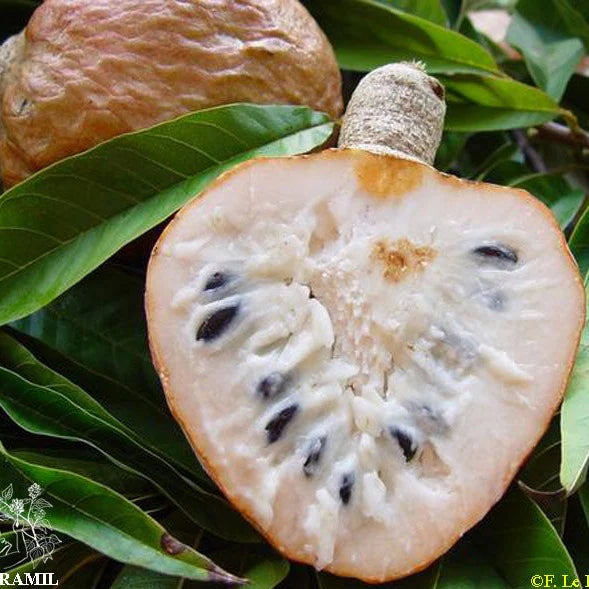Love it? Add to your wishlist
Your favorites, all in one place. Shop quickly and easily with the wishlist feature!
[message]
[title]
[message]

Veliyath Gardens
Couldn't load pickup availability
The Custard Apple (Annona reticulata), known in various regions as Ramphal, Bullock’s Heart, or Sugar Apple, is one of the most cherished members of the tropical fruit family. With its soft, custard-like pulp and naturally sweet aroma, this fruit brings together the essence of flavor and nourishment in every bite. Belonging to the Annonaceae family, it is a small yet fast-growing deciduous or semi-evergreen tree that has earned global admiration — not only for its luscious fruit but also for its long-standing use in traditional medicine across continents.
From backyard gardens to commercial orchards, the Custard Apple has become a beloved addition for tropical fruit lovers, offering both visual charm and nutritious rewards.
The Custard Apple tree is a modest-sized fruit tree, typically reaching a height of 4 to 10 meters, with a rounded canopy and smooth brown bark. It thrives in warm tropical and subtropical climates, preferring well-drained sandy loam soil and abundant sunlight.
The leaves are simple, glossy, and aromatic, releasing a faint fragrance when crushed. During the flowering season, the tree produces small, yellowish-green blossoms that attract pollinators like bees and beetles. The fruit that follows is heart-shaped or oval, with a smooth or slightly netted outer skin that ripens to a reddish-brown hue.
Inside, the flesh is creamy white to pale pink, delightfully soft and sugary, giving rise to its famous “custard” texture. The plant starts to bear fruit within 2 to 3 years, making it a fast and rewarding grower for gardeners and orchard owners alike.
Each fruit of Annona reticulata holds a treasure of sweetness beneath its delicate skin. The pulp is rich, smooth, and aromatic, with a flavor that combines the sweetness of sugar and the creaminess of custard. Though slightly less intense in flavor compared to other Annona varieties like Atemoya or Soursop, it captivates fruit enthusiasts with its refreshing, melt-in-the-mouth texture.
The fruit is best enjoyed fresh, but its pulp is also widely used in culinary applications — from ice creams, smoothies, and milkshakes to dessert flavorings and jams. It is a versatile fruit that adds both taste and nutrition to the diet.
The Custard Apple is often described as a natural dessert with healing powers. Beyond its irresistible taste, this fruit offers a wide spectrum of nutritional and therapeutic benefits that support overall well-being.
Custard apples are loaded with Vitamin C, Vitamin B6, Potassium, Magnesium, and Dietary Fiber — all essential for boosting energy, improving immunity, and maintaining cardiovascular health.
The fruit’s high fiber content promotes healthy digestion, alleviates constipation, and supports nutrient absorption. Its natural enzymes also help in soothing the stomach and improving metabolism.
The magnesium and potassium in custard apples help regulate blood pressure levels, reducing strain on the heart and arteries. Regular consumption supports balanced lipid levels and overall cardiac health.
Enriched with flavonoids and antioxidants, custard apples combat oxidative stress, protect against free radicals, and support skin rejuvenation. Its natural anti-inflammatory properties help prevent chronic ailments and promote tissue repair.
In traditional medicine, various parts of the Annona reticulata plant — including its bark, leaves, and seeds — are used to treat conditions such as fevers, dysentery, epilepsy, and bacterial infections. Leaf extracts have been known to reduce hypertension and inflammation, while the bark is often used in cardiac and respiratory treatments.
Growing a Custard Apple tree is relatively easy, making it an ideal choice for both home gardeners and orchard cultivators.
Climate: Prefers warm, humid, and frost-free tropical conditions.
Soil: Best grown in well-drained loamy or sandy soil, enriched with organic matter.
Sunlight: Requires full sun for optimum flowering and fruiting.
Watering: Moderate watering during the growing season, with well-regulated moisture levels.
Fruiting Time: Typically 2 to 3 years after planting.
Maintenance Level: Moderate — occasional pruning and fertilization improve yield and tree health.
Regular feeding with organic compost and timely pruning of old branches ensures robust growth and abundant harvests.
In tropical regions like India, Sri Lanka, and Central America, the Custard Apple has deep cultural and culinary roots. Known locally as Ramphal, it holds spiritual importance and is often offered in rituals or shared during festive seasons.
The pulp is a favorite ingredient in traditional sweets, ice creams, milkshakes, and sherbets, lending its creamy texture and mild fragrance to enhance the flavor profile. Its naturally cooling properties make it a summer favorite, cherished for its ability to refresh and revitalize the body.
The Custard Apple Fruit Plant (Annona reticulata) is more than just a fruit-bearing tree — it’s a symbol of tropical abundance, natural sweetness, and traditional healing. From its luscious, custard-like pulp to its centuries-old medicinal uses, every part of this plant holds immense value.
For those looking to enrich their gardens with a tree that offers both beauty and bounty, the Custard Apple is a perfect choice. Its fast growth, moderate care requirements, and exceptional fruiting potential make it a rewarding addition to any tropical garden.
At Veliyath Gardens, we take pride in offering this classic tropical fruit plant, encouraging plant enthusiasts to embrace its charm and benefits. With each fruit harvested, you taste the essence of nature’s sweetness — pure, nourishing, and timeless.
Climate: Prefers warm, humid, and frost-free tropical conditions.
Soil: Best grown in well-drained loamy or sandy soil, enriched with organic matter.
Sunlight: Requires full sun for optimum flowering and fruiting.
Watering: Moderate watering during the growing season, with well-regulated moisture levels.
Supports Digestive Health
The fruit’s high fiber content promotes healthy digestion, alleviates constipation, and supports nutrient absorption. Its natural enzymes also help in soothing the stomach and improving metabolism.
Heart and Blood Pressure Regulation
The magnesium and potassium in custard apples help regulate blood pressure levels, reducing strain on the heart and arteries. Regular consumption supports balanced lipid levels and overall cardiac health.
In tropical regions like India, Sri Lanka, and Central America, the Custard Apple has deep cultural and culinary roots. Known locally as Ramphal, it holds spiritual importance and is often offered in rituals or shared during festive seasons.
The pulp is a favorite ingredient in traditional sweets, ice creams, milkshakes, and sherbets, lending its creamy texture and mild fragrance to enhance the flavor profile. Its naturally cooling properties make it a summer favorite


